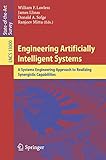Engineering Artificially Intelligent Systems [electronic resource] : A Systems Engineering Approach to Realizing Synergistic Capabilities /
Material type: TextSeries: Information Systems and Applications, incl. Internet/Web, and HCI ; 13000Publisher: Cham : Springer International Publishing : Imprint: Springer, 2021Edition: 1st ed. 2021Description: XII, 281 p. 105 illus., 76 illus. in color. online resourceContent type:
TextSeries: Information Systems and Applications, incl. Internet/Web, and HCI ; 13000Publisher: Cham : Springer International Publishing : Imprint: Springer, 2021Edition: 1st ed. 2021Description: XII, 281 p. 105 illus., 76 illus. in color. online resourceContent type: - text
- computer
- online resource
- 9783030893859
- 005.3 23
- QA76.76.A65
Introduction: Motivations for and Initiatives on AI Engineering -- Architecting Information Acquisition To Satisfy Competing Goals -- Trusted Entropy-Based Information Maneuverability for AI Information Systems Engineering -- BioSecure Digital Twin: Manufacturing Innovation and Cybersecurity Resilience -- Finding the path toward design of synergistic humancentric complex systems -- Agent Team Action, Brownian Motion and Gambler’s Ruin -- How Deep Learning Model Architecture and Software Stack Impacts Training Performance in the Cloud -- How Interdependence Explains the World of Teamwork -- Designing Interactive Machine Learning Systems for GIS Applications -- Faithful Post-hoc Explanation of Recommendation using Optimally Selected Features -- Risk Reduction for Autonomous Systems -- Agile Systems Engineering in Building Complex AI Systems -- Platforms for Assessing Relationships: Trust with Near Ecologically-valid Risk, and Team Interaction -- Principles for AI-Assisted Attention Aware Systems in Human-in-the-loo[p Safety Critical Applications -- Interdependence and vulnerability in systems: A review of theory for autonomous human-machine teams -- Principles of a Accurate Decision and Sense-Making for Virtual Minds. .
Many current AI and machine learning algorithms and data and information fusion processes attempt in software to estimate situations in our complex world of nested feedback loops. Such algorithms and processes must gracefully and efficiently adapt to technical challenges such as data quality induced by these loops, and interdependencies that vary in complexity, space, and time. To realize effective and efficient designs of computational systems, a Systems Engineering perspective may provide a framework for identifying the interrelationships and patterns of change between components rather than static snapshots. We must study cascading interdependencies through this perspective to understand their behavior and to successfully adopt complex system-of-systems in society. This book derives in part from the presentations given at the AAAI 2021 Spring Symposium session on Leveraging Systems Engineering to Realize Synergistic AI / Machine Learning Capabilities. Its 16 chapters offer an emphasis on pragmatic aspects and address topics in systems engineering; AI, machine learning, and reasoning; data and information fusion; intelligent systems; autonomous systems; interdependence and teamwork; human-computer interaction; trust; and resilience. The chapter “How Interdependence Explains the World of Team work” is available open access under a Creative Commons Attribution 4.0 International License via link.springer.com.


There are no comments on this title.